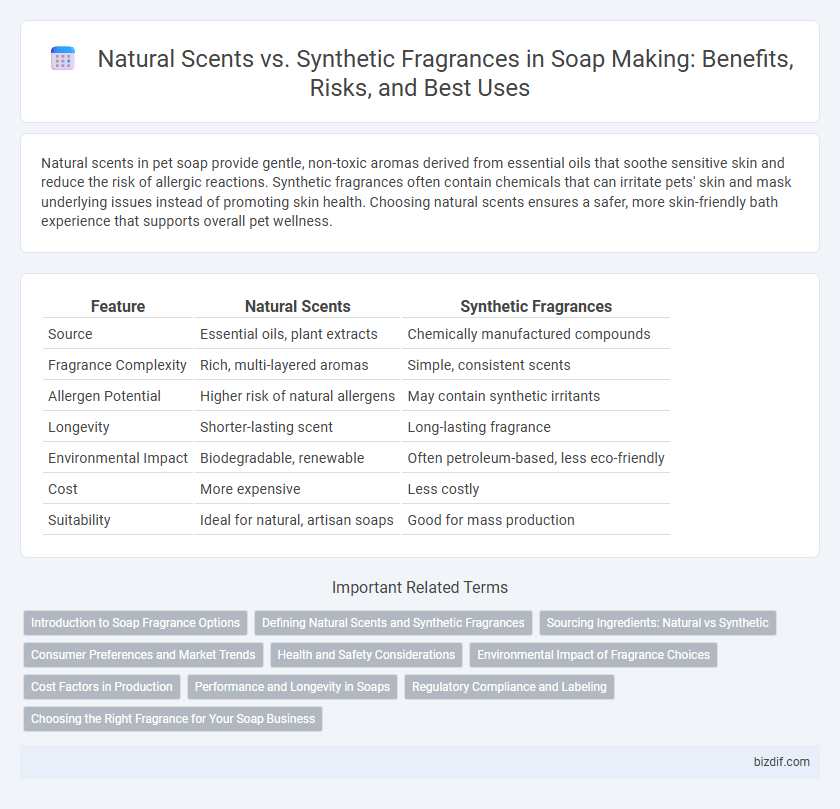Natural scents in pet soap provide gentle, non-toxic aromas derived from essential oils that soothe sensitive skin and reduce the risk of allergic reactions. Synthetic fragrances often contain chemicals that can irritate pets' skin and mask underlying issues instead of promoting skin health. Choosing natural scents ensures a safer, more skin-friendly bath experience that supports overall pet wellness.
Table of Comparison
| Feature | Natural Scents | Synthetic Fragrances |
|---|---|---|
| Source | Essential oils, plant extracts | Chemically manufactured compounds |
| Fragrance Complexity | Rich, multi-layered aromas | Simple, consistent scents |
| Allergen Potential | Higher risk of natural allergens | May contain synthetic irritants |
| Longevity | Shorter-lasting scent | Long-lasting fragrance |
| Environmental Impact | Biodegradable, renewable | Often petroleum-based, less eco-friendly |
| Cost | More expensive | Less costly |
| Suitability | Ideal for natural, artisan soaps | Good for mass production |
Introduction to Soap Fragrance Options
Natural scents in soap making derive from essential oils and plant extracts, offering organic aromas that are often therapeutic and biodegradable. Synthetic fragrances provide a broader range of consistent and vibrant scent profiles, created through chemical formulations to enhance longevity and intensity. Choosing between natural and synthetic options impacts the soap's appeal, allergen potential, and environmental footprint.
Defining Natural Scents and Synthetic Fragrances
Natural scents in soap making derive from essential oils and botanical extracts, offering authentic aromas that reflect their plant origins and provide therapeutic benefits. Synthetic fragrances are chemically formulated compounds designed to mimic natural scents or create novel aromas, often ensuring stronger, longer-lasting fragrance stability. Understanding the composition of natural versus synthetic fragrances is crucial for soap makers aiming to balance scent authenticity, skin sensitivity, and product longevity.
Sourcing Ingredients: Natural vs Synthetic
Natural scents in soap making are derived from essential oils, plant extracts, and sustainably harvested botanicals, ensuring eco-friendly and biodegradable ingredients. Synthetic fragrances are chemically formulated in laboratories, offering consistent scent profiles but often relying on petroleum-based compounds. Choosing natural sources supports organic farming and reduces chemical exposure, while synthetic options provide cost-effective and long-lasting aroma solutions.
Consumer Preferences and Market Trends
Consumer preferences in soap making increasingly favor natural scents derived from essential oils and botanicals due to their perceived health benefits and eco-friendliness. Market trends indicate a rising demand for organic and cruelty-free products, driving brands to reduce synthetic fragrance use, which often causes allergies or irritations. Natural scents also leverage the clean-label movement, appealing to environmentally conscious buyers seeking transparency and sustainability.
Health and Safety Considerations
Natural scents derived from essential oils contain fewer harmful chemicals and allergens compared to synthetic fragrances, making them generally safer for sensitive skin and reducing the risk of respiratory irritation. Synthetic fragrances often include phthalates and other chemical additives linked to hormone disruption and allergic reactions, posing potential health risks during soap use. Choosing soap with natural scents supports safer skin contact and minimizes exposure to potentially toxic compounds commonly found in synthetic fragrance blends.
Environmental Impact of Fragrance Choices
Natural scents derived from essential oils tend to have a smaller environmental footprint, as they come from renewable plant sources and biodegrade more easily. Synthetic fragrances often rely on petrochemicals, contributing to pollution and posing challenges for waste management and ecosystem health. Choosing natural essential oils in soap making supports sustainable practices by reducing reliance on fossil fuels and minimizing toxic residues in water systems.
Cost Factors in Production
Natural scents in soap making often incur higher production costs due to expensive raw materials like essential oils and the need for sustainable sourcing practices. Synthetic fragrances offer a cost-effective alternative, providing consistent scent profiles at a lower price point with easier scalability. Balancing cost factors influences product pricing strategies and market positioning within the soap industry.
Performance and Longevity in Soaps
Natural scents in soap making often provide a subtle, authentic aroma but tend to have shorter fragrance longevity due to their volatile organic compounds breaking down quickly during saponification. Synthetic fragrances, engineered for stability, maintain their scent strength and consistency throughout the soap's shelf life and use, enhancing overall performance in artisan and commercial soap products. The choice between natural and synthetic impacts the soap's aging process, customer experience, and marketability based on fragrance intensity and durability.
Regulatory Compliance and Labeling
Natural scents in soap making often face less stringent regulatory requirements compared to synthetic fragrances, which are subject to rigorous safety assessments by agencies like the FDA and IFRA. Accurate labeling is crucial, with synthetic fragrances requiring detailed disclosure of chemical components to comply with Consumer Product Safety Commission (CPSC) guidelines. Ensuring regulatory compliance not only supports consumer transparency but also minimizes legal risks associated with allergen declarations and ingredient safety in soaps.
Choosing the Right Fragrance for Your Soap Business
Natural scents derived from essential oils offer authentic aromas and appeal to eco-conscious customers seeking chemical-free products. Synthetic fragrances provide a wider range of consistent, long-lasting scents often at a lower cost, ideal for scaling soap production. Balancing customer preferences, ingredient compatibility, and cost-efficiency is crucial when selecting fragrances for a successful soap business.
Natural Scents vs Synthetic Fragrances Infographic

 bizdif.com
bizdif.com